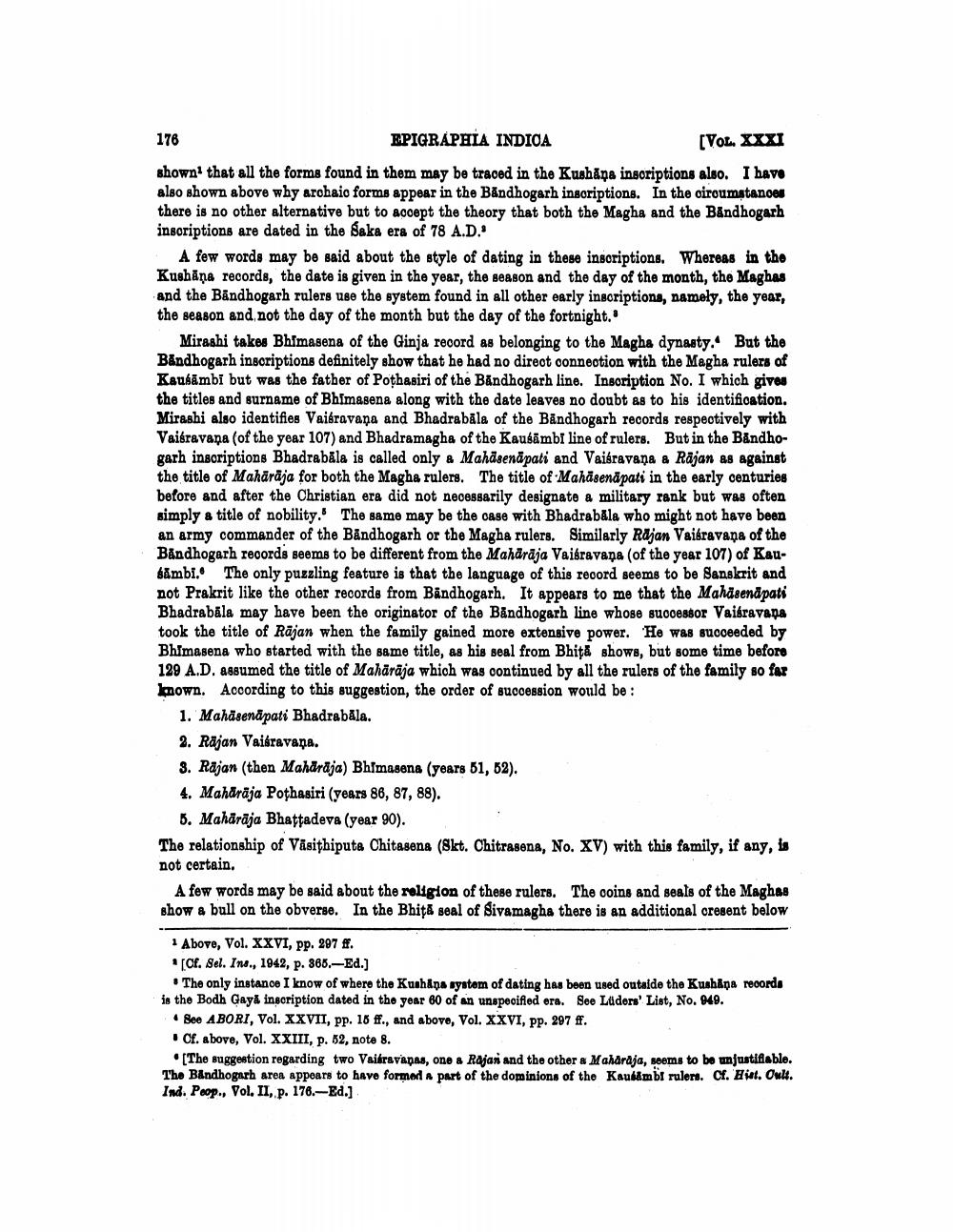________________
176
EPIGRAPHIA INDICA
[VOL. XXXI
shown that all the forms found in them may be traced in the Kushipa inscriptions also. I have also shown above why archaic forms appear in the Båndhogarh inscriptions. In the circumstances there is no other alternative but to accept the theory that both the Magha and the Båndhogarh inscriptions are dated in the Baka era of 78 A.D."
A few words may be said about the style of dating in these inscriptions. Whereas in the Kushāņa records, the date is given in the year, the season and the day of the month, the Maghas and the Bandhogarh rulers use the system found in all other early inscriptions, namely, the year, the season and not the day of the month but the day of the fortnight.
Mirashi takes Bhimasena of the Ginja record as belonging to the Magha dynasty. But the B&ndhogarh insoriptions definitely show that he had no direct connection with the Magha rulers of Kaubāmbi but was the father of Pothasiri of the Bandhogarh line. Inscription No. I which gives the titles and surname of Bhimasena along with the date leaves no doubt es to his identification. Mirashi also identifies Vaisravana and Bhadrabāla of the Bandhogarh records respectively with Vaisravana (of the year 107) and Bhadramagha of the Kaubambi line of rulers. But in the Bandhogarh insoriptions Bhadrabála is called only a Mahasenapati and Vaisravana a Rajan as against the title of Mahārāja for both the Magha rulers. The title of Mahasenapati in the early centuries before and after the Christian era did not necessarily designate a military rank but was often simply a title of nobility. The same may be the case with Bhadrabala who might not have been an army commander of the Bandhogarh or the Magha rulers. Similarly Rajan Vaibravana of the Båndhogarh records seems to be different from the Maharaja Vaisravana (of the year 107) of Kausimbi. The only puzzling feature is that the language of this record seems to be Sanskrit and not Prakrit like the other records from Bandhogarh. It appears to me that the Mahasenapati Bhadrabāla may have been the originator of the Bandhogarh line whose successor Vaisravana took the title of Rājan when the family gained more extensive power. He was succeeded by Bhimasena who started with the same title, as his seal from Bhiță shows, but some time before 129 A.D. assumed the title of Maharaja which was continued by all the rulers of the family so far Inown. According to this suggestion, the order of succession would be:
1. Mahäsenāpati Bhadrabāla. 2. Rajan Vaisravana. 3. Rajan (then Maharaja) Bhimasena (years 61, 62). 4. Maharaja Pothasiri (years 86, 87, 88).
B. Mahārāja Bhattadeva (year 90). The relationship of Văsițhiputa Chitasena (Skt. Chitrasena, No. XV) with this family, if any, is not certain.
A few words may be said about the religion of these rulers. The coins and seals of the Maghas show a bull on the obverse. In the Bhiţă seal of Sivamagha there is an additional cresent below
1 Above, Vol. XXVI, PP. 297 ff.
[Of. Sel. Ins., 1942, p. 866.-Ed.) • The only instance I know of where the Kuhana system of dating has been used outaide the Kushina records is the Bodh Gaya inscription dated in the year 60 of an unspecified ora. See Lüders' List, No. 949.
See ABORI, Vol. XXVII, pp. 16 ff., and above, Vol. XXVI, PP. 297 ff. Cf. above, Vol. XXIII, p. 52, note 8. • The suggestion regarding two Vaidravanas, one a Rajan and the other s Maharaja, seems to be unjustifiable. The Bandhogarh area appears to have formed a part of the dominions of the Kaubambl rulers. Cf. Hist. Oult. Ind. Peop., Vol. II, p. 176.-Ed.]




